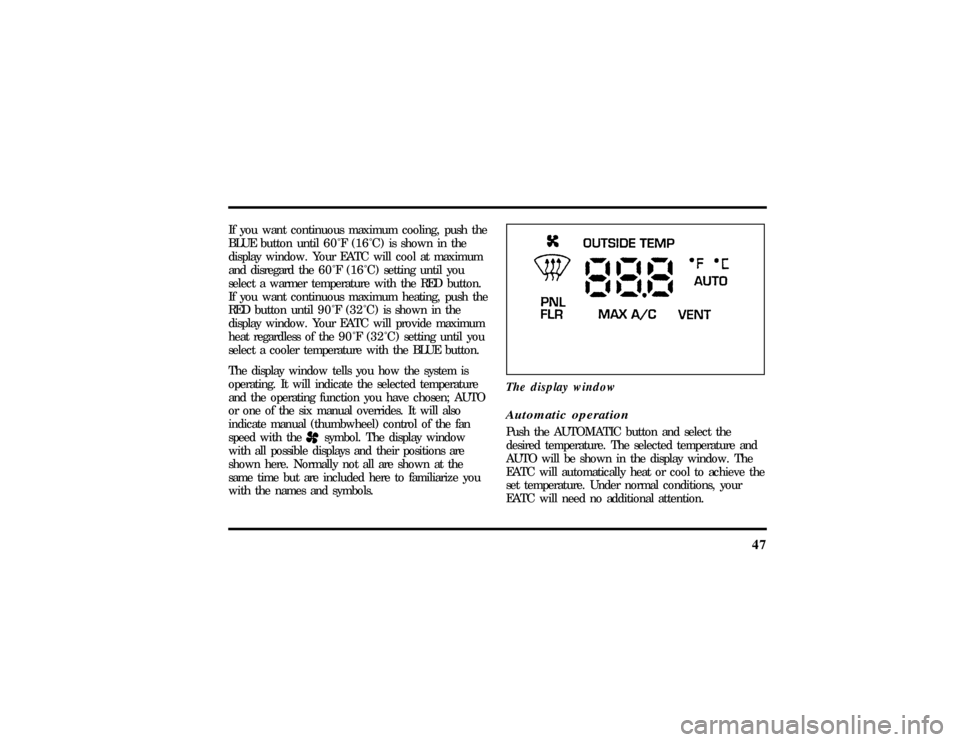1997 LINCOLN CONTINENTAL heating
[x] Cancel search: heatingPage 21 of 321

17
OdometerThe odometer tells you the total number of miles
(kilometers) your vehicle has been driven.
If the odometer displays the word Error, please
contact your dealer for service.SpeedometerThe speedometer tells you how many miles
(kilometers) per hour your vehicle is moving.TachometerThe tachometer displays the approximate engine
revolutions per minute (rpm), or how fast the
engine is running.
You can drive your vehicle at most rpm points on
the tachometer but you must stay out of the red
zone.
If you drive with the tachometer in the red zone,
you may damage the engine.
Engine Coolant Temperature GaugeThis gauge indicates the temperature of the engine
coolant, not the coolant level. If the coolant is not
at its proper level or mixture, the gauge indication
will not be accurate.
The pointer moves from the C (cold) mark into the
NORMAL band as the engine coolant warms up. It
is acceptable for the pointer to fluctuate within the
NORMAL band under normal driving conditions.
Under certain driving conditions such as, heavy stop
and go traffic, or driving up hills in hot weather,
the pointer may indicate at the top of the NORMAL
band.
If, under any circumstances, the pointer moves
above the NORMAL band, the engine is overheating
and continued operation may cause engine damage.
If your engine overheats:
1. Pull off the road as soon as it is safely possible.
2. Turn off the engine.
File:03fnisc.ex
Update:Mon Jun 17 14:14:40 1996
Page 51 of 321

47
If you want continuous maximum cooling, push the
BLUE button until60ÊF(16ÊC) isshown in the
display window. Your EATC will cool at maximum
and disregard the60ÊF(16ÊC)setting until you
select a warmer temperature with the RED button.
If you want continuous maximum heating, push the
RED button until90ÊF(32ÊC) isshown in the
display window. Your EATC will provide maximum
heat regardless of the90ÊF(32ÊC)setting until you
select a cooler temperature with the BLUE button.
The display window tells you how the system is
operating. It will indicate the selected temperature
and the operating function you have chosen; AUTO
or one of the six manual overrides. It will also
indicate manual (thumbwheel) control of the fan
speed with the
Hsymbol. The display window
with all possible displays and their positions are
shown here. Normally not all are shown at the
same time but are included here to familiarize you
with the names and symbols.The display window
Automatic operationPush the AUTOMATIC button and select the
desired temperature. The selected temperature and
AUTO will be shown in the display window. The
EATC will automatically heat or cool to achieve the
set temperature. Under normal conditions, your
EATC will need no additional attention.
File:05fncfc.ex
Update:Fri Sep 6 14:53:57 1996
Page 52 of 321

48The AUTO temperature displayWhen in AUTOMATIC and weather conditions
require heat, air will be sent to the floor. But, a
feature is included in your EATC to prevent
blowing cold air to the floor if the engine coolant is
not warm enough to allow heating. In 3-1/2
minutes or less, the fan speed will start to increase
and the airflow will change to the floor area.If unusual conditions exist (i.e., window fogging,
etc.), the six manual override buttons allow you to
select special air discharge locations. A thumbwheel
allows you to adjust the fan speed to suit your
needs.
Temperature selectionThe RED and BLUE buttons at the upper left of the
Control are for temperature selection. The RED
Button will increase the set temperature and the
BLUE Button will lower the set temperature.
Pressing a button and releasing it will change the
set temperature one degree. Holding either button
in will rapidly change the temperature setting in
one degree increments to either65ÊF(18ÊC)
(BLUE) or85ÊF(29ÊC)(RED). Then, the set
temperature will jump 5 Ê and stop at either60ÊF
(16ÊC)which is maximum cooling or90ÊF(32ÊC)
which is maximum heating. When you select60ÊF
(16ÊC) or90ÊF(32ÊC), the fanwill go to HI speed
for maximum air flow.
File:05fncfc.ex
Update:Fri Sep 6 14:53:57 1996
Page 53 of 321

49
The normally selected temperature range is between
68ÊF(20ÊC) and78ÊF(26ÊC).Changing the
temperature setting by several degrees outside this
range or overriding to60ÊF(16ÊC) or90ÊF(32ÊC)
will not speed up the heating or cooling process.
Temperature display
Press MAX A/C and DEF at the same time to
switch between Fahrenheit and Celsius. If the
battery is disconnected, the display will revert
to Fahrenheit.
Fan speed and thumbwheelYour EATC automatically adjusts the fan speed to
the existing conditions. You must push
AUTOMATIC for automatic fan speed operation. To
control the fan speed yourself, use the thumbwheel
which will cancel the automatic fan speed control.
The thumbwheel is located at the extreme right
side of the EATC control panel. It is a vertical
control marked with a fan symbol. Rotate up for HI
and down for LO speeds.
File:05fncfc.ex
Update:Fri Sep 6 14:53:57 1996
Page 177 of 321

175
During the Traction Control
TM
function, which most
often occurs during low speed acceleration on
slippery surfaces, a noise may be heard coming from
the engine compartment. This is normal and may
last for a few seconds during the acceleration of the
vehicle.
In general, this system improves your vehicle's
stability and acceleration performance when road
conditions warrant. Traction Control
TM
is fully
effective at all vehicle speeds.
If the Traction Control
TM
system is cycled
excessively, the brake portion of the system will
shut down to prevent the front brakes from
overheating. A limited Traction Control
TM
function
using engine torque will still control wheels from
spinning. A cooling down period is required to
prevent damage to the brakes. This time periodvaries and depends on brake usage during the
cooling down period. Anti-Lock braking is not
affected and will function normally during the cool
down period.
After the cool down period, the full Traction
Control
TM
function is restored.
Rear Air Suspension Adaptive
Ride Control SystemYour vehicle has an air suspension system with
automatic rear load leveling and automatic ride
control. This system keeps the rear of your vehicle
at a constant level by adding air or releasing air
from the springs. Ride and handling is enhanced by
firming shock absorber performance during certain
road conditions, steering maneuvers, braking, and
accelerations and is returned to the driver selected
ride calibration when driver or road surface induced
motion changes are completed.
File:09fngfc.ex
Update:Fri Sep 6 08:48:49 1996
Page 307 of 321

309
Child safety restraints.......... 148
child safety belts........... 162
child safety seats........... 149
Child safety seats............ 149
and air bags............. 149
attaching with tether straps...... 160
automatic locking mode
(retractor)..........140, 149
in front seat............. 149
in rear outboard seat......... 149
in rear seat............. 149
tether anchorage hardware...... 161
Chime
headlamps on............ 15
key in ignition............ 63
safety belt.............. 10
Circuit breakers, see also fuses...... 192
Cleaning your vehicle.......... 268
chrome and aluminum parts...... 268
exterior............... 269
exterior lamps............ 269
fabric................ 270headlamps.............. 269
instrument panel......... 7,269
interior............... 269
interior lamps............ 269
mirrors............. 93,111
plastic parts............. 269
polishing.............. 268
rustproofing............. 268
safety belts............. 269
tail lamps.............. 269
upholstery and interior trim...... 269
washing............... 268
waxing............... 268
wheels............... 270
Climate control system
air conditioning........... 45
electronic automatic temperature
control.............. 45
heating............... 45
Clock................. 60
File:fnixc.ex
Update:Tue Sep 17 08:28:54 1996
Page 312 of 321

314
calculating............. 184
definition.............. 183
driving with a heavy load....... 183
location............... 183
H
Hazard flashers............. 68
Headlamps
aiming............... 264
autolamp system........... 57
checking alignment.......... 261
cleaning.............. 261
daytime running lights........ 56
flashing............... 65
high beam............. 65
replacing bulbs........... 261
turning on and off.......... 57
warning chime............ 15
Head restraints............. 131
Heated mirrors............. 112
Heating
electronic automatic temperature control
system.............. 45High beams
indicator light............ 15
operation............ 56,65
Hood................. 223
latch location............ 223
lubrication specifications....... 273
release lever............. 223
working under the hood....... 221
Horn................. 69
I
Idle, relearning..........216, 221
Ignition
chime............... 63
positions of the ignition........ 62
removing the key.......... 63
Indicator lights and chimes (see Lights) . . . 7
Infant seats (see Safety seats)....148, 149
Instrument panel............. 7
cleaning............... 269
Interval wipers............. 66
File:fnixc.ex
Update:Tue Sep 17 08:28:54 1996